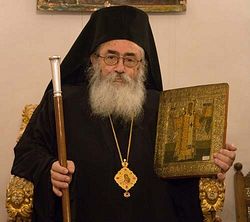By Sophia Kishkovsky
Sinai, August 1, 2011

|
| The Abbot of the monastery of St. Catherine, Mt. Sinai |
St Catherine’s Monastery is famous for its library, which houses one of the world’s largest collections of ancient manuscripts and codices, as well as for its sizable collection of sixth-century icons that survived the wave of Byzantine iconoclasm that destroyed most at that time.
Condition and climate control
Komashko said the climatic conditions at Sinai played a significant role in the preservation of the icons. “In order for an icon to [remain in good condition] for as long as possible, it must have stable temperature and humidity [levels]… There is no problem with this [at] Sinai, which has unique natural conditions for the preservation of icons.”
She said that the icons, which were on view in the Chapel of the Burning Bush before being hidden away in the sacristy several decades ago, showed signs of light restoration. “They were cleaned of their slightly darkened original coating and re-coated with a very distinctive lacquer,” said Komashko. She noted that the icons kept in the sacristy remained in almost perfect condition, compared with those housed in the monk’s cells and used daily. These suffered from wear-and-tear and paint loss and were crudely restored in the 19th century.
From Russia with love
How did this ancient monastery come to be a repository for such a large number of Russian treasures? According to scholars who have traced the links between Russia and Sinai, the first recorded Russian pilgrim to the monastery was a 15th-century monk. He was subsequently followed by a stream of Russian merchants and officials, all of whom came bearing gifts. The monks also sent emissaries to Moscow from 1519, and continued to send envoys into the 17th and 18th centuries. These envoys returned to Sinai laden with gifts, some of which came from the tsars.
The recent expedition to Sinai, headed by Komashko, included other researchers from Moscow including staff from the State Tretyakov Gallery as well as the State Research Institute for Restoration. Previous expeditions conducted by the Andrei Rublev Museum in 2004 and 2005 sought to catalogue Russian works in the monastery’s churches and sacristy. Komashko said that there may be more Russian works yet to be discovered within the monastery’s walls as researchers are not allowed to enter the sacristy and the monks might not be able to distinguish Russian items from other works of art.
The Russian Orthodox Church also participated in the most recent expedition and will be publishing a photographic book about its results.
